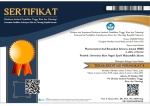Isolasi dan Karakterisasi Bakteri Asam Laktat dari Kefir Susu Kambing Saanen (Capra aegagrus Hircus)
Abstract
Kefir merupakan minuman kesehatan yang memiliki efek positif bagi manusia yang bahannya bisa berasal dari susu kambing dan sapi. Perubahan susu menjadi masam pada kefir terjadi karena adanya berbagai jenis mikroba yang hidup bersimbiosis pada bulir kefir. Sejauh ini belum banyak dilaporkan jenis BAL pada kefir yang diperoleh dari susu kambing Saanen di Indonesia. Penelitian ini bertujuan untuk mengetahui jenis dan karakteristik BAL yang terkandung dalam kefir susu kambing Saanen. BAL diisolasi dengan menggunakan media MRS yang disuplemen dengan CaCO3 1% dan diinkubasi 48 jam suhu 37oC. Selanjutnya dilakukan karakterisasi BAL dengan cara mengamati morfologi koloni dan sel, karakterisasi fisiologi dan biokimia yang di antaranya: uji katalase, motilitas, tipe fermentasi, pertumbuhan pada suhu 11oC, 37oC, dan 45oC, serta uji pertumbuhan yang disuplemen dengan NaCl 5%, 6.5%, dan 10%. Penelitian ini berhasil memperoleh 4 isolat yang sesuai dengan karakteristik umum BAL, yaitu Gram positif berbentuk bulat, tidak membentuk spora, dan bersifat katalase negatif. Semua isolat bersifat non motil, homofermentatif, dapat tumbuh pada suhu 11oC-45oC dan konsentrasi NaCl 5%-10%. Hasil karakterisasi menunjukkan keempat isolat termasuk dalam genus Enterococcus. Peran Enterococcus sebagai penghasil asam laktat didiskusikan dalam kajian ini.
Keywords
References
Cho, G. S. et al. (2018) ‘Isolation and characterization of lactic acid bacteria from fermented goat milk in Tajikistan’, Journal of Microbiology and Biotechnology, 28(11), pp. 1834–1845. doi: 10.4014/jmb.1807.08011.
Getaneh, G. et al. (2016) ‘Review on Goat Milk Composition and its Nutritive Value’, Journal of Nutrition and Health Sciences. Annex Publishers, LLC, 3(4), p. 401. doi: 10.15744/2393-9060.3.401.
Goyal, R. et al. (2012) ‘Characterization of the Lactobacillus Isolated from Different Curd Samples’, African Journal of Biotechnology, 11(79), pp. 14448–14452. doi: 10.5897/AJB11.310.
Hawaz, E. (2014) ‘Isolation and identification of probiotic lactic acid bacteria from curd and in vitro evaluation of its growth inhibition activities against pathogenic bacteria’, African Journal of Microbiology Research, 8(13), pp. 1419–1425. doi: 10.5897/AJMR2014.6639.
Ismail, Y. S., Yulvizar, C. and Mazhitov, B. (2018) ‘Characterization of lactic acid bacteria from local cows milk kefir’, IOP Conference Series: Earth and Environmental Science, 130(1), pp. 1–8. doi: 10.1088/1755-1315/130/1/012019.
Ismail, Y. S., Yulvizar, C. and Putriani (2017) ‘Isolasi, karakterisasi dan uji aktivitas antimikroba bakteri asam laktat dari fermentasi biji kakao (Theobroma cacao L.)’, Jurnal Bioleuser, 1(2).
Jay, J. M., Loessner, M. J. and Golden, D. A. (2005) Modern Food Microbiology. 7th edn. Edited by D. R. Heldman. New York: Springer.
Khandelwal, P. et al. (2016) ‘Lactic Acid Bacteria’, in Ray, R. C. and Montet, D. (eds) Fermented Foods. Part I: Bi. New York: CRC Press, pp. 127–146.
Kıvanç, M. and Yapici, E. (2015) ‘Kefir as a Probiotic Dairy Beverage : Determination Lactic Acid Bacteria and Yeast’, International Journal of Food Engineering, 1(1), pp. 55–60. doi: 10.18178/ijfe.1.1.55-60.
König, H. and Fröhlich, J. (2009) ‘Lactic Acid Bacteria’, in König, H., Fröhlich, J., and Unden, G. (eds) Biology of Microorganism on Grapes, in Must and in Wine. Berlin: Springer-Verlag, pp. 3–6.
Lahtinen, S. et al. (2012) Lactic acid bacteria: Microbiological and functional aspects. Fourth. New York: Taylor & Francis Group.
Misgiyarta and Widowati, S. (2007) ‘Seleksi dan Karakterisasi Bakteri Asam Laktat (BAL) Indigenus’, Prosiding Seminar Hasil Penelitian Rintisan dan Bioteknologi Tanaman, 24(4), pp. 38–57. doi: 10.1111/j.1540-5842.2007.00924.x.
Otles, S. and Cagindi, O. (2003) ‘Kefir: A Probiotic Dairy-Composition, Nutritional and Therapeutic Aspects’, Pakistan Journal of Nutrition, 2(2), pp. 54–59. doi: 10.1093/pasj/48.2.377.
Pop, C. et al. (2014) ‘Influence of Different Growth Conditions on the Kefir Grains Production, Used in the Kefiran Synthesis’, Bulletin UASVM Food Science and Technology, 71(2), pp. 147–153. doi: 10.15835/buasvmcn-fst.
Pradana, I. P. E., Dewi, S. S. and Wilson, W. (2018) ‘Aktivitas Kefir dan Isolat Bakteri Asam Laktat dari Kefir dalam Menghambat Pertumbuhan Salmonellatyphi’, in Prosiding Seminar Nasional Mahasiswa Unimus, pp. 170–177.
Rahayu, W. P. and Nurwitri, C. . (2012) Mikrobiologi Pangan. Edited by P. Komalasari. Bogor: Penerbit ITB Press. Available at: https://books.google.co.id/books?hl=en&lr=&id=Ho8SEAAAQBAJ&oi=fnd&pg=PP1&ots=GrTddsDhjD&sig=ql72_x_mvSffQvKpDZu0RxzHlgQ&redir_esc=y#v=onepage&q&f=false (Accessed: 3 March 2021).
Romadhon, R., Subagiyo, S. and Margino, S. (2012) ‘Isolasi Dan Karakterisasi Bakteri Asam Laktat Dari Usus Udang Penghasil Bakteriosin Sebagai Agen Antibakteria Pada Produk-Produk Hasil Perikanan’, Saintek Perikanan : Indonesian Journal of Fisheries Science and Technology, 8(1), pp. 59–64. doi: 10.14710/IJFST.8.1.59-64.
Suardana, I. W., Utama, I. H. and Wibowo, H. (2014) ‘Identifikasi Escherichia coli O157:H7 dari Feses Ayam dan Uji Profil Hemolisisnya pada Media Agar Darah’, Jurnal Kedokteran Hewan, 8(1), pp. 1–5.
Trujillo, M. E. et al. (eds) (2015) Bergey’s Manual of Systematics of Archaea and Bacteria, Bergey’s Manual of Systematics of Archaea and Bacteria. Wiley. doi: 10.1002/9781118960608.
Yuniastuti, A. (2014) Probiotik ( Dalam Perspektif Kesehatan ). 1st edn. Semarang: UNNES PRESS.
DOI: 10.15408/pbsj.v2i2.19970
Refbacks
- There are currently no refbacks.






